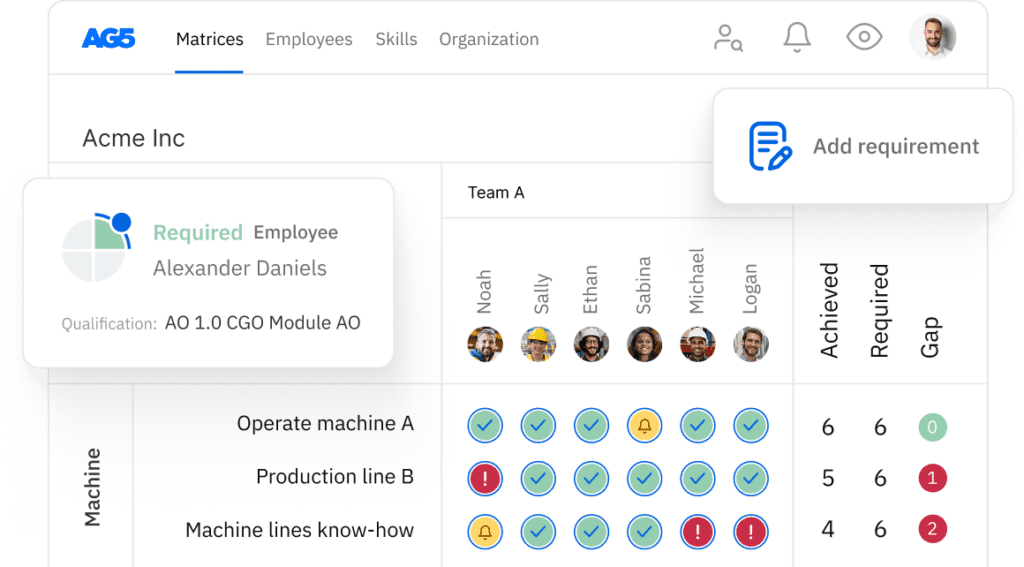Defining learning objectives? 10 practical tips & examples
Explore the essence of defining learning objectives in this article. Discover practical methods and valuable insights to craft effective learning outcomes.

The drive and eagerness to continue learning and growing are important prerequisites for success in today’s workplace – principally because jobs, professions, and their associated technologies are changing so rapidly. Defining your learning objectives clearly and concisely can help enormously.
But what exactly are learning objectives? How do you measure them? What constitutes a proper learning objective? And how can you use SMART methods to define your learning objectives?
We’ll be providing answers to all these questions in this article with several tips and practical examples.
What are learning objectives?Copied
Before we dive into how to define learning objectives effectively, it’s important to know what a learning objective is exactly. A learning objective is a goal that you set for yourself relating to specific skills and knowledge you want to acquire.
This definition also differentiates between learning objectives and performance objectives. You set performance objectives in terms of clearly defined results, while focusing primarily on the outcome.
Setting performance objectives works well for relatively simple and clear-cut tasks, but not so well for complex and oftentimes drawn-out processes such as acquiring and developing new and intricate skills. This is why learning objectives focus more on the learning process itself rather than the results or outcome of a training program.
Defining clear, concise, concrete learning objectives also provides a whole host of additional benefits. For example, focusing on acquiring a new skill or competence helps clarify the professional growth and development you’re making as a whole and setting milestones helps you monitor the progress you’re making.
Learning objectives also prompt you to pay better attention and become more deeply engaged, as well as allowing you to get a clearer picture of what’s important and what’s not, and what works and what doesn’t. Ultimately, this means we also learn more effectively and efficiently.
Measuring learning objectivesCopied
It’s important that you can monitor and measure learning objectives in order to get the most out of them. A common problem with learning objectives is that they’re too vague and too loosely defined. If this is the case, they’re more akin to intentions, wishes, or resolutions than concrete objectives.
Fortunately, there are plenty of methods available to help you measure your learning objectives and gain greater clarity. The best known and most widely used is:
SMART: Specific – Measurable – Acceptable – Realistic – Time-based

5 steps to defining SMART learning objectivesCopied
At AG5, we’re big SMART fans. Why? Because a SMART objective gives direction, defines the result, and directs our behaviors accordingly. What’s more, it clearly states when we want to achieve a particular objective. Direct and to the point!
Defining a SMART goal also significantly increases the likelihood that you’ll actually achieve your learning objective, rather than it remain a mere intention. Apply the system step by step:
- Specific (Step 1) – define the learning objective clearly and concisely. What do you want to achieve? Who else is involved in the learning process? Where and when will this take place? And why do you want to achieve this learning objective?
- Measurable (Step 2) – attribute a performance or quality level to the effort required. This assumes that systems, methods, or procedures are in place to determine the extent to which you’ve achieved the objective at any given moment. If possible and relevant, create a benchmark before you start in order to determine your current situation.
- Acceptable (Step 3) – ensure and create support. If it’s your personal learning objective, then only you have to accept the goal you’re setting for yourself. But if it’s a manager who’s setting learning objectives for his or her staff, then it’s vital that all staff members support and accept these goals.
- Realistic (Step 4) – make it viable and achievable. Setting the bar too high is highly detrimental to motivation and often leads to disappointment. Always assess whether a learning objective or training program is doable with reasonable effort.
- Time-based (Step 5) – set a deadline or time frame, clearly stating your start and end dates. When will you be starting the activities in question? When will you finish? And when will you have achieved the objectives defined?
ExamplesCopied
So much for the theory, but what constitutes a good learning objective in practice? Let’s take a look at a few examples.
1. Learn to use new tools and technologies
If your company were on the verge of implementing a new communications tool or ordering system, for example, learning about the new technology before its roll-out would constitute an example of a good learning objective.
Draft a plan and investigate the new tool by reading blogs, watching instructional videos or demos, or use other available tools.
But what are the benefits? Firstly, you’re less likely to run into as many surprises as you would if you had to hit the ground running with the new tool already implemented. Secondly, your efforts may even inspire your co-workers to do the same. Thirdly, system adoption will be faster and smoother for the whole organization.
2. Improve presentation skills
Lots of people dread having to give a presentation. What’s more, research has shown that 40% of people – to a greater or lesser degree – suffer from glossophobia (a fear of public speaking). A pity given that presentation skills are an asset in the workplace, as they can ease communication and clarify processes or new ideas.
That’s why improving presentation skills is a highly relevant learning objective for many professionals. As with any other learning objective, it’s sensible to give yourself plenty of time and to create a solid plan. Don’t expect to transform from a moderate glossophobic into the world’s greatest presenter in only two weeks. It’s far more realistic and sensible to take things step by step and to make steady progress.
3. Address body language
We communicate not only with spoken and written words, but also with our bodies and facial expressions. What’s more, these often play a very important role, especially when looking to make a good first impression.
You can communicate more effectively once you’ve identified what non-verbal messages you’re sending and what impressions you’re creating with your body language. Conveying a sense of respect for co-workers and business acquaintances is perhaps the most important factor of all.
4. Learn about other company departments
Certainly in larger organizations, departments often tend to become silos. This generally does little to improve efficiency. To prevent this from happening, it’s good to have staff acquaint themselves with other departments throughout your company.
There’s little doubt that gaining a greater understanding of the ins and outs affecting other departments can only be beneficial to all concerned. Why not have staff members spend two or three months working in another department, and incorporate the challenges, obstacles, and insights they encounter into their learning objectives?

Tips for defining learning objectivesCopied
Although learning objectives are always quite subjective and personal, the general tips listed below can prove useful.
1. Don’t define too many learning objectives
Don’t overdo it with your learning objectives. As with many things in life, moderation is key. By setting too many learning objectives, you not only place exceptionally high demands on yourself, but you also run the risk that you’ll fail to perform at your best. What’s more, you’ll soon lose sight of the larger picture.
2. Keep it short and simple
Define your learning objective clearly and concisely. Don’t use long, convoluted sentences. Instead, use clear, bulleted lists that get straight to the point. Doing so helps create and maintain the right focus.
3. Don’t define learning objectives to broadly
People often tend to define learning objectives too broadly. Goals such as “I want to be more open and spontaneous” or “I want to land a top job within three weeks” are too broad and general. It often helps to split learning objectives into smaller goals. Doing so also allows you to create milestones by which you can monitor your progress more effectively.
A useful tool for this purpose is a list of these sub-goals, which you check off as you complete each step towards achieving your overall learning objective.
4. Stay true to yourself
Select learning objectives that reflect who you are. This relates to professional objectives that you think are important or skills that will genuinely benefit you in your professional career.
If management imposes learning objectives, it’s important that they ensure staff members understand the personal benefits and that managers do their utmost to encourage them to achieve these goals.
5. Have someone else take a look
It can really help to have someone else take a look at the learning objectives you’ve set for yourself. Does he or she understand exactly what it is you’re looking to achieve when they read your goal definitions? If not, you probably haven’t defined them clearly or concisely enough yet.
6. Clear a path
Often, we attempt to achieve a goal without taking the time to reflect fully. What’s more, we often tend to choose things we find easy or are familiar with. Many a project has stagnated and stranded as soon as the boundaries of our comfort zones come into sight.
It’s a reflex response that we’re not always aware of, but is very common, nonetheless. For example, you make exquisite products but procrastinate about setting up an online store because you’re dreading the prospect of having to deal with the technical side of running a business.
The weird thing about how our brains are wired is that these obstacles often appear insurmountable to us. Write down which barriers that are preventing you from achieving a specific goal and then seek tangible solutions.
ClarityCopied
There are several tools available that can help you simplify and clarify your learning objectives. For example, AG5’s software helps staff record and keep track of their important goals in a clear and simple skills matrix.
What’s more, both HR managers and staff receive automated notifications about any certification or refresher training courses that are about to expire or lapse. And all this information relating to skills, competences, and certification is stored centrally in the cloud and available remotely for all authorized staff members.
If you’re looking to make setting learning objectives clearer and simpler, while managing your staff’s skills and competences, feel free to get in touch or schedule a demo. You wouldn’t be the first leading company or professional to have done so!
Use AG5 to identify skill gaps
Say goodbye to Excel matrices. Start using AG5’s plug and play skill matrix software.
ISO27001 certified
Start your 14-day free trial

